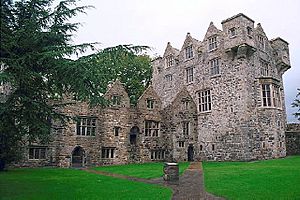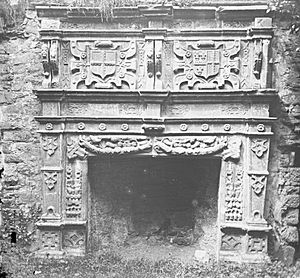Donegal Castle facts for kids
Donegal Castle (which is Caisleán Dhún na nGall in Irish) is a cool old castle right in the middle of Donegal Town in County Donegal, Ireland. It was once the main home of the O'Donnell clan, who were very powerful leaders in Ireland for hundreds of years, from the 400s to the 1500s. For a long time, most of the castle was just ruins, but it was beautifully fixed up in the early 1990s. Now, it's open for everyone to visit and explore!
Contents
What Does Donegal Castle Look Like?
The castle has a tall, rectangular tower, called a keep, which was built in the 1400s. Later, a fancy new part was added in the 1600s, called a Jacobean style wing. There's also a small gatehouse at the entrance that looks like a mini version of the main tower.
The castle sits right on a bend in the River Eske, close to where it meets Donegal Bay. A wall built in the 1600s surrounds the whole area. Most of the castle was built using limestone found nearby, with some sandstone too.
A Look Back: The History of Donegal Castle
What Does "Donegal" Mean?
The name Donegal (Dún na nGall in Irish) means "Fort of the Foreigner." This might come from a Viking fort that was in the area and was destroyed way back in 1159. However, because the town has grown so much over hundreds of years, we haven't found any old proof of this Viking fort.
Who Built the Castle?
Aodh Ruadh Ó Domhnaill I, also known as Red Hugh O'Donnell I, was a very rich and important leader of the O'Donnell clan. He built Donegal Castle in the 1460s or early 1470s. In 1474, he and his wife, Nuala, also started a Franciscan friary (a type of monastery) further down the river. There's a local story that says a secret tunnel connected the castle and the friary, but no one has ever found it!
Donegal Castle was known as one of the best Gaelic castles in Ireland. In 1566, an important English visitor, Sir Henry Sidney, wrote a letter describing it as "the largest and strongest fortress in all Ireland." He also said it was "one of the fairest situated in good soil and so nigh a portable water a boat of ten tonnes could come within ten yards of it." This means it was big, strong, and in a great spot right by the water.
New Owners and Changes
In 1607, after a big war called the Nine Years' War, the O'Donnell leaders left Ireland in an event known as the Flight of the Earls. In 1611, during a time called the Plantation of Ulster, the castle and its lands were given to an English captain named Basil Brooke.
The O'Donnells had badly damaged the castle when they left, so that no one else could use it against them. But Basil Brooke quickly fixed it up. He also added new windows, a special roof part called a gable, and a large manor-house wing to the main tower. All these additions were in the fancy Jacobean style.
The Brooke family owned the castle until the 1670s, when they moved away. They sold the castle to the Gore family, who later became important leaders called the Earls of Arran. Under the Gore family, the castle slowly fell into ruins in the early 1700s. In 1898, the owner at the time, the 5th Earl of Arran, gave the castle to the Office of Public Works (OPW).
Bringing the Castle Back to Life
In the early 1990s, the Office of Public Works (OPW) started a big project to fix up the castle. They put new roofs and floors in the main tower, making sure they looked just like the original ones from the 1400s and 1600s. The stone walls were also repaired. The manor wing was partly re-roofed. Some of the oak wood used for the repairs came from the Colebrooke Estate, which is near Brookeborough in County Fermanagh. Parts of the outside of the tower were also covered with a special rough plaster called harled.
Today, Donegal Castle is open to the public. It often hosts fun events, like evenings celebrating Irish culture or Ulster Scots traditions.




